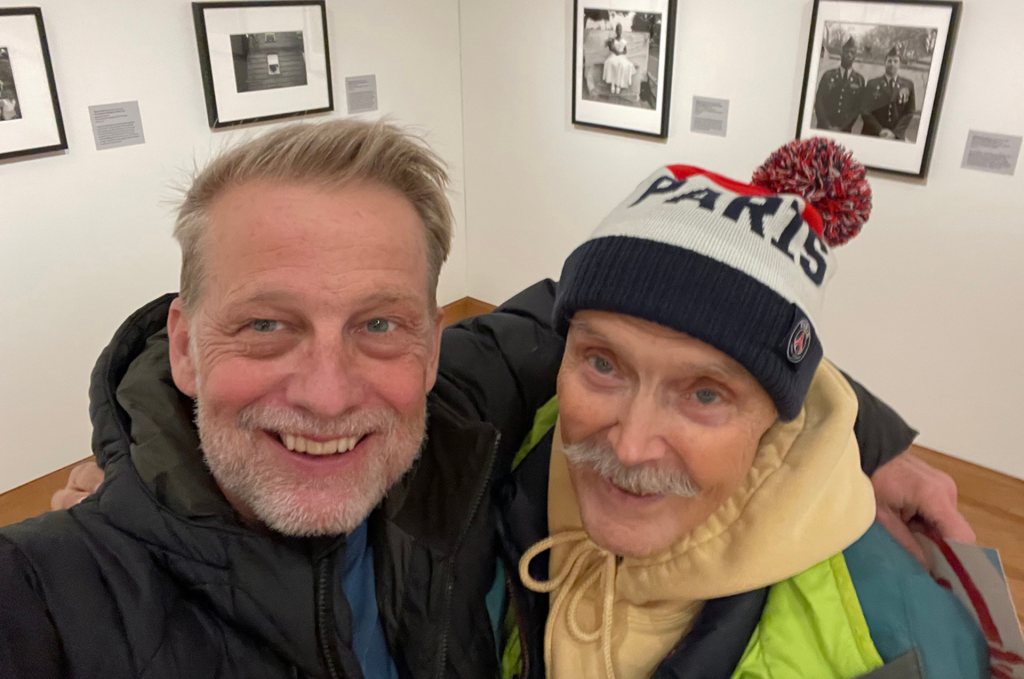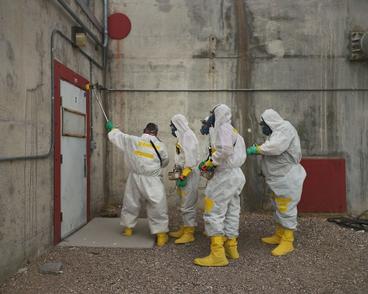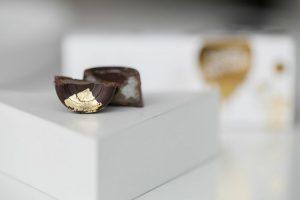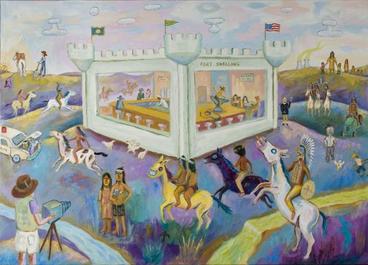It’s a freezing cold day in December when I meet photographers Tom Arndt and Michael Dvorak at their shared studio space in downtown Minneapolis. Tom and Michael make coffee for all three of us, trading jokes as they move around the studio. Coffee in hand, Tom and I sit to chat while Michael moves to the darkroom to develop some of his most recent work.
Ashley Cope: You were in Paris in November for your recent book launch. How was that experience?
Tom Arndt: Over the years now we’ve kind of acquired this family in Paris, which now has expanded even more. This publisher, Atelier EXB, is really a good one. And what’s so cool is it’s all women…They are so good, I had no worries. I’m not modest about this book, because this came together in a year. Books like this don’t happen in a year.
Ashley Cope: You have an exhibition up in Paris in conjunction with the book, right?
Tom Arndt: Yes, at my gallery in Paris. It’s up until the last week in January [2022].
Tom procures a copy of his most recent book, American Reflections. On the cover, I see not only the reflection of a young woman through the window of a bustling candy shop in 1979, but also reflections of Minnesota’s past. The cover of Arndt’s book is a photograph he took of Hennepin Avenue and 7th Street nearly forty-five years ago. The theater in the background advertises Grease starring John Travolta and Olivia Newton John in large letters, and bulky 1970s sedans roll down Hennepin Avenue. Arndt’s work, which is featured in Locally Grown: Documentary Photography of Minnesota Communities, spans a period of nearly fifty years. As we continue to flip through American Reflections together, Tom brings up a question he is often asked about his photographic practice: how does he approach his subjects to photograph them?
Tom Arndt: When I approach people, my exposure, my focus, everything is set so that when I’m with someone I’m pretty fast and immediate, because you can embarrass people…Some of it is about the personality of the photographer. I am outgoing to people…I’m like the people I photograph. I just don’t disappear. Like I had a show called Where I Live a few years ago at [Howard Greenberg Gallery in New York], and across the top of the gallery it said: ‘I am like the people I photograph, I’m not traveling through.’
Ashley Cope: I think that’s something people can see in Locally Grown as well…The artists taking these pictures have a connection to the people and places they photograph. I think all the photos in the show get that across.
Tom Arndt: Oh, absolutely.
Ashley Cope: And in all your pictures, there seems to be a real human connection.
Tom Arndt: It’s so intuitive to me, but it’s also a process of editing. I’ve made some very angry pictures, very juvenile. But I say “No, this is not fair.” Even if these people are people I really dislike I cannot—they can’t answer back if I present a photograph that sees them in a way that is one sided.
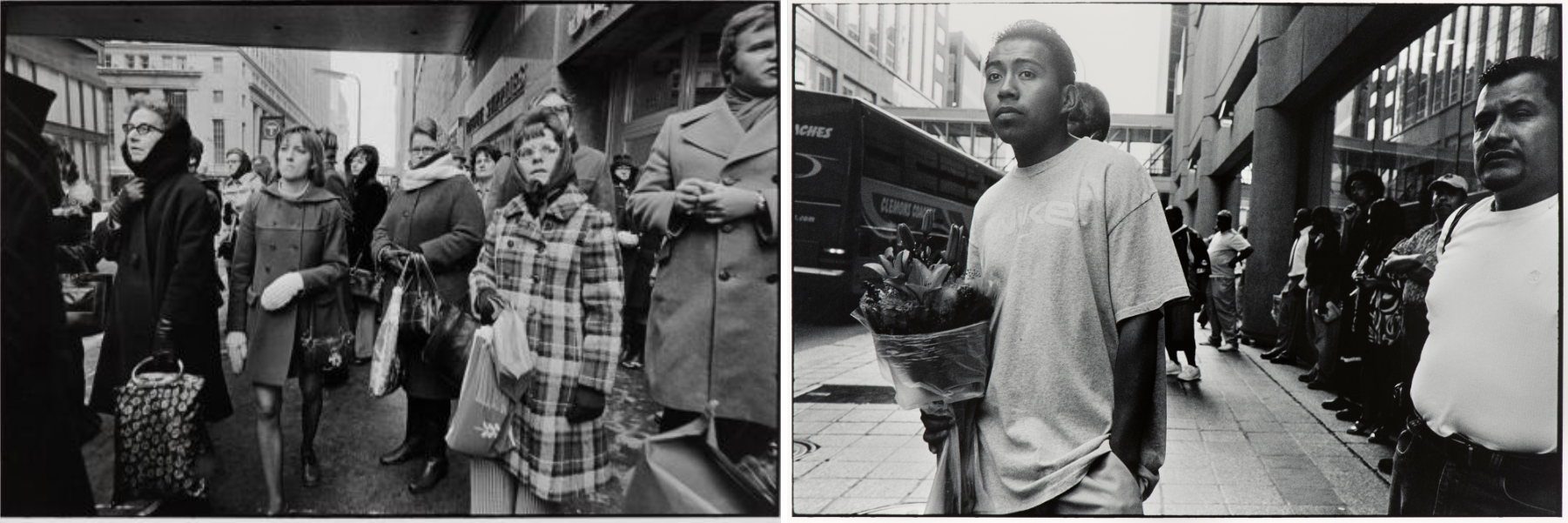
Ashley Cope: In Locally Grown there is a pair of your photographs, both of people waiting for the bus in downtown Minneapolis. One is from the 1970s and the other is from the early-2000s, but they both share the same experience of waiting downtown for the bus. In your perspective, how have things changed or stayed the same in the Twin Cities over the years?
Tom Arndt: Oh, it’s changed a lot. When I photographed the [Nicollet] Mall which was built around 1970, I made photographs while the IDS tower was being built, and I remember the beautiful art deco building they tore down to build the IDS. It was a big Woolworth’s building, and it was beautiful… There were more people downtown, and [buildings] had more character. All the construction now looks like dormitory housing.
Ashley Cope: I’m also reminded of your photograph of a mother and child in a window downtown, and that same apartment building looks pretty much unchanged! Same pipes, same electricity meter, same alley—
Tom Arndt: Yes, the Kenosha apartments on 12th street.
Ashley Cope: Yep! It looks exactly the same today.
Tom Arndt: Yes, it does. Next year it will be 50 years [since the photograph was taken]. I remember it so well.
Ashley Cope: I also noticed you photograph a lot of mothers and children.
Tom Arndt: I do. I could do a book of them [mothers and children]. I photograph dads too, but more moms. I do that a lot.
We continue to look through Tom’s newest book until an image of two smiling women at the 1984 Democratic National Convention prompts Tom to pull out another publication for us to peruse. From a stack of periodicals and books behind him, Tom finds a November 1984 copy of the magazine American Photographer in which his photographs of Walter Mondale’s presidential campaign were included alongside similar pictures by well-known photographer Robert Frank.
Tom Arndt: Robert Frank was very in tune with the people he photographed. He was not a critic…And when we did that article (“Politics as Unusual” in American Photographer) together, he was really supportive and kind to me. He really liked my work and that meant a lot to me.
Ashley Cope: I notice in the “Politics as Unusual” article, you and Robert Frank are credited a bit differently. It says here “Minnesotan photojournalist Tom Arndt” and “incomparable observer of Americans Robert Frank.” Do you notice yourself being labelled specifically a “Minnesotan photographer” a lot?
Tom Arndt: I don’t think it’s like that much anymore. Because most of what I do now is in Europe—like ninety percent. I mean, I love my home state, I’m thrilled to be in the show at the Weisman. Every time I can show at home it’s cool. But what is gratifying to me now is to be able to have this kind of response in Paris where they don’t know me. I’m just this old guy that’s making these pictures, and the response is really pretty cool. I mean, you can see that everyone [in Paris] worked so hard on this book [American Reflections].
Turning through page after page of Arndt’s striking photographs, I’m struck by the power of his black and white images which feel so evocative, nostalgic, and lively despite their muted tones. I ask Tom to tell me more about his love for film photography. What is it about these black and white images that has captivated him for over fifty years?
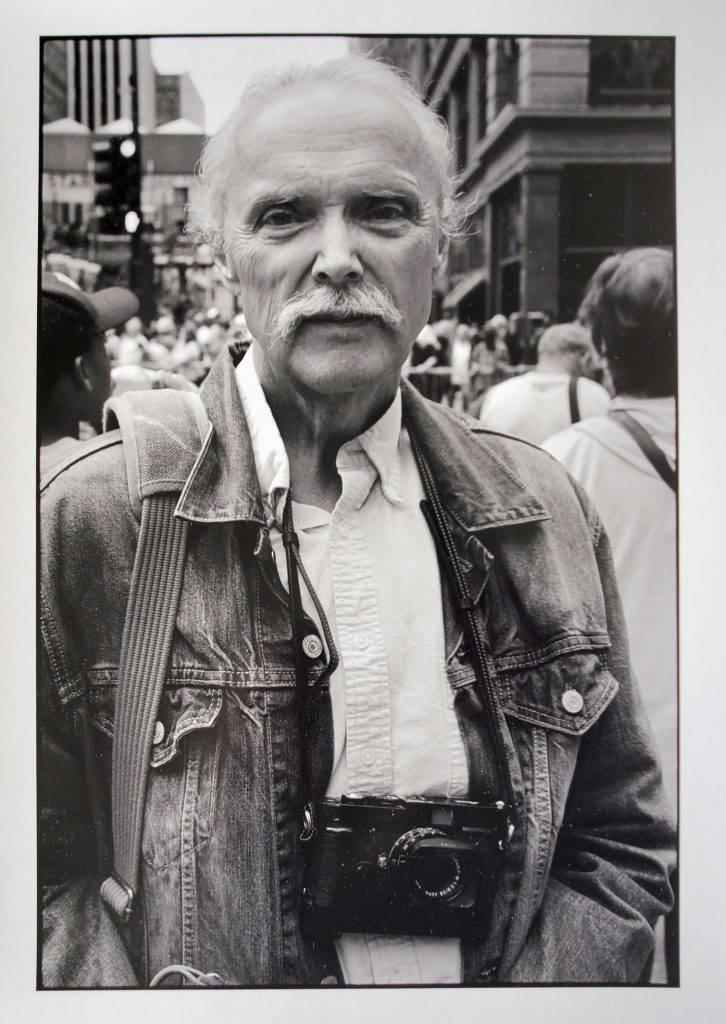
Tom Arndt: I love colored photography; I love Vivian Maier’s color photographs. [Black and white] is just my choice. There’s a texture and a timelessness to black and white that I like. I love the tonalities—creating all these subtle mid-tones and blacks…It’s not that colors can be arbitrary, but it’s just a different process and there’s an emotional texture to black and white. And I like the physical part, you know? Because Mike and I and all us photographers are processing our own film, we have to noodle around to find out who’s got the best developer. We all left Kodak because the current tri-ex film, for us guys it’s just not usable. They’ve taken silver out and now use dyes, and I just can’t do it. Plus, it’s twelve dollars a roll! That is ridiculous. [Photography] used to be the people’s art. That was the cool thing about it. Now I’m walking around with an $11000 camera when I’m walking around with my Laika…Sometimes when I’m walking around people go ‘Oh, that’s a cool old camera,’ and they think it’s cool that I’m shooting film…I said [to one sitter], ‘This picture is not going out on Instagram. I won’t see this for a couple of months.’
Ashley Cope: I suppose it must be exciting, and maybe even nerve-wracking, to see the finished picture for the first time in the darkroom.
Tom Arndt: Oh yes. It’s all those things. It’s always exciting, it never stops.
Talk of the development process is a reminder that Michael is in the nearby darkroom as we speak, developing his images and seeing the result of his work for the first time.
Ashley Cope: Tell me about your working relationship with Michael Dvorak. He mentioned to me that you’ve been his mentor for over twenty years. How did you meet and how has working with him been over the past few decades?
Tom Arndt: Mike came to Chicago when we lived there. He photographed me for some article or for some MCAD thing. But then we lost track of each other until I moved back home [to Minnesota]. Mike would know better than me exactly what happened, but we’ve just been hanging out ever since. When I moved into the studio, I bought two enlargers, so I just said “Well I’ll use this one, Mike, and you use this one.” There was a mutual respect, and sometimes we would photograph a lot of things together. We photograph a lot of things not together. It’s just kind of a relationship [that] works.
Ashley Cope: You and Michael have worked together for so long, but your works in Locally Grown are certainly unique to your own styles. There seems to be a spontaneity in your images in the exhibition whereas many of Michael’s are often very symmetrical, almost geometric images of people posing. Do you find you take a very spontaneous and candid approach in your work?
Tom Arndt: Sometimes. It all depends on the situation. Sometimes I’m just responding to the light and the movement I see, and to the people. And then I figure out how to make a structure that hopefully will work, and most of the time it doesn’t, but that’s why we don’t have delete buttons on film cameras—there are some pictures in this book [American Reflections] that I probably would have deleted. But each moment is its own in how you structure that content. Sometimes I will stop and ask people, be very formal about it. Sometimes it’s just what happens in the instant.
Ashley Cope: For the pictures that do look so spontaneous, I imagine that the time between seeing what you want to photograph and being able to capture it is very quick.
Tom Arndt: It is. You can’t check, you can’t look at what you’ve done. I don’t know what I’ve done, I just think, “Did I make my exposure, did I make my focus?” These are things you find out about later.
Ashley Cope: How often does it turn out the way you hope?
Tom Arndt: I’m not a big shooter, in my life I’ve shot about 6,500 rolls of film; some photographers my age have shot 40,000 rolls of film. I don’t waste a lot of film. My ratio of success I think is pretty good. If I shoot, say 60 shots, that’s more work for me to go through the backlog of film. I already have a lifetime of work ahead of me going through my old film. I really don’t have to make another picture, but I also can’t stop.
Ashley Cope: What things, what subjects you are looking for when you go out now?
Tom Arndt: Now I photograph more neighborhoods, the ephemera: what do people put in their yards, how are their bushes, how are their boundaries, stuff like that. We also go out west every summer and I do a lot in Montana, North Dakota. So more of what I do is out west now.
Ashley Cope: In addition to your more recent projects in Europe and across the United States, are there certain things about Minnesota that keep you coming back again and again? When you’re here, what are you looking for? What stories are you telling?
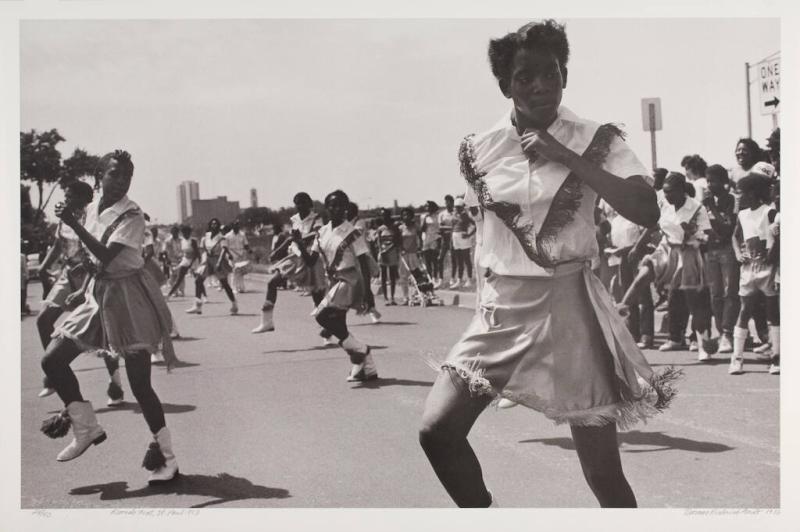
Tom Arndt: I’ll go to certain events, like I love to go to Kolacky Days in Montgomery. In my book Home there’s pictures from Kolacky Days from 1975. I still go there. I’m probably photographing their grandchildren! But it’s still relevant to me. Or I’ll go to Kaposia days in South St. Paul, or Dam Days in Morristown and Bullhead Days in Waterville. Or I’ll go photograph Fourth of July in Duluth. And then I’ll go out to North Dakota and Montana in the summer. But even though times pass, I still photograph the [Minneapolis] St. Patrick’s Day parade.
Ashley Cope: There are a lot of parades in Locally Grown.
Tom Arndt: Parades go back to Rome, and to every town, every culture. We are still a nation of immigrants, this country. And even though its hundreds of years later, people still have their ethnic moments, and they are moments of pride and singularity. And these times are often easy for me to photograph because people are in a good mood and its easier for me to do work and record these moments in their lives.”
At the end of my conversation with Tom, Michael Dvorak comes around the corner to ask if we’d like to come into the darkroom to watch him develop a picture he took while recently in Paris for Tom’s book launch and exhibition. We enter the adjoined darkroom which is neatly furnished with the two enlargers Tom mentioned as well as three separate tubs of liquid on a central island. The lighting in the room is necessarily dim to allow for handling of light-sensitive materials. As Michael finishes setting up, Tom chimes in with a smirk, “Need a light on so you can see better, Mike?” Both photographers share a laugh as Michael finishes gathering his materials and ushers me over to get a better look. With accuracy and finesse, Michael exposes the film in the enlarger, adjusting by hand to ensure he achieves the contrast he wants. After exposure, Michael moves the sheet to the developer, the liquid in the first of the three tubs in the darkroom. Tipping the tub back and forth to get an even distribution of the developer on the print, Michael says, “Stand right here, and you can see magic happen.” Before my eyes, an image suddenly begins to appear, and the magic of photography captivates us all.
